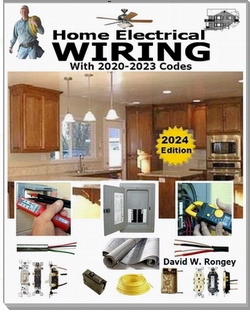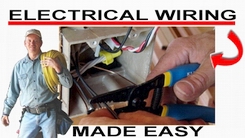» Need Electrical Help? Ask the Electrician
Wire Stripping Guidelines

|
By Dave Rongey
Summary: Some of the 14 gauge wires I stripped to attach to receptacles will sometimes have a ring near the base of the wire after it is stripped. I use a good quality craftsman wire stripper, making sure that I use the 14 gauge notch. © By: Dave Rongey |
How to Strip Electrical Wire
Electrical Question:
Some of the 14 gauge wires I stripped to attach to receptacles will sometimes have a ring near the base of the wire after it is stripped, and I use a good quality craftsman wire stripper, making sure that I use the 14 gauge notch.
Are these marks on the wire okay?
I'm scared that I might have accidentally used the 16 gauge notch at certain points around my house while working in a box with short wires. I really doubt it, but I know it is possible, and I know how dangerous nicked wires can be. If, for whatever reason I did do that.
Is that likely to start a fire?
I really hate the idea of having to go back to every outlet and switch I worked on and inspect the splices and terminal connections, when there may not even be a problem.
Should I worry about this, or will this be safe?
Again, I don't think I would have used the 16 gauge notch accidentally without noticing it, but you never know. I just want to know so that I can stop worrying.
Thanks! Matt M.
From Dave:
Stripping wires is something that is very important and we all should pay attention to. This is why I am a strict advocate of a few guidelines that will help prevent improper wire stripping.
How to Strip Electrical Wires
Understand the Wire Size or Wire Gauge
The conductor that is protected by the insulation is a certain diameter, whether measured by metric or U.S. Standards, the actual conductor is based upon the electrical current it is designed for.
The importance of using the right wire stripping tools
There have been a wide variety of wire stripping tools produced, some are great but there are a few that I would definitely advise against, especially for the novice handyman or electrician. The styles I will stay away from do not have a preset mechanism that will prevent clamping down on the wire to the point of leaving a scribed nick or impression on the conductor. The best type of electrical wire strippers are those that have a built-in stopping mechanism in place to prevent over clamping on the wire conductor size that is identified on the wire stripping tool.
The importance of removing the correct length of insulation
Most electrical devices including switches and receptacle outlets show on the molding a strip gauge . This is the length of insulation that should be removed to make the best connection possible with the device. Stripping the wire insulation too short can produce an insecure connection and could produce an overheated area which could in time end up arcing and burning away from the connection which would produce a loss of continuity in the circuit, or a loss of power from that point on in the circuit. A wire that is stripped too long can become a hazard because it will allow the extra bare area of the conductor to be vulnerable for coming into contact with other wires such as the ground, or could become a danger to anyone who may come in contact with the wired device.
The danger of human error and judgment
Wire size. It is important to identify what wire size you are working with. All wires are required to be identified by either impression printing that is embedded onto the wire jacket or insulation of the individual wire, or an imprinted visible description onto the outer jacket or individual wire insulation. There will be other information included with this description as well.
One way to identify the wire gauge is to look at the amperage of the circuit breaker and compare this to the wire table found on the website, however you should exercise caution because there are some installations of aluminum wire, where the gauge of wire is required to be larger than copper.
There is also the caution which must be taken due to other wiring which could have been installed by an unqualified person that may not be up to adopted electrical code requirements. If this is found to be the case with any wiring, the circuit should be investigated and verified to be correct.
Another way to identify the gauge of the wire conductor is to examine a spare piece of the wire of the same size and using a good wire stripping tool to remove the insulation. Starting with a large gauge first. If the insulation does not remove freely then select the next size smaller gauge.
Caution must be taken to be absolutely sure you have identified the correct wire gauge.
What can happen with nicks or impressions on wire conductors?
A nick or impression could cause be the beginning of a breaking point when the wire is bent during handling at times such as when a receptacle outlet is having the wires attached to it, then inserting the device into the outlet box. It is possible that the nicked area of the wire conductor may break off preventing current flow or even possibly shorting with another conductor, or the conductor cold make contact with the grounded box enclosure and cause a direct short to ground which would cause the circuit breaker to trip off or cause a fuse to blow. This is assuming that the circuit is properly sized and protected by the correct protection device.
What if your wiring installation contains nicked impressions?
If your wiring installation has been installed and become nicked leading to damage causing a loss of the continuity of the circuit then this will be brought to your attention because of a fault in the circuit. If the wiring is functioning even though there may be nicks on the wire, will this be a problem? That is hard to say, but would depend upon the electrical loads that are placed on the circuit, and several other factors.
It's better to be safe than sorry. I am an advocate of always hiring a licensed professional electrician who performs work under the authority of the local building department or agency who will inspect the wiring project. Even if you installed wiring in your home your self, it should fall under the guidelines of this proper procedure which will ensure that the work has been done correctly and that your electrical project will function safely.
Be Careful and Be Safe - Never Work on Energized Circuits!
The Safest Way to Test Electrical Devices and Identify Electric Wires!The Non-Contact Electrical TesterThis is a testing tool that I have had in my personal electrical tool pouch for years, and is the first test tool I grab to help identify electrical wiring. It is a Non-contact tester that I use to easily Detect Voltage in Cables, Cords, Circuit Breakers, Lighting Fixtures, Switches, Outlets and Wires. Simply insert the end of the tester into an outlet, lamp socket, or hold the end of the tester against the wire you wish to test. Very handy and easy to use.
The Quickest Way to Check for Faulty Electrical Wiring!The Plug-In Outlet TesterThis is the first tool I grab to troubleshoot a problem with outlet circuit wiring. This popular tester is also used by most inspectors to test for power and check the polarity of circuit wiring. It detects probable improper wiring conditions in standard 110-125 VAC outlets Provides 6 probable wiring conditions that are quick and easy to read for ultimate efficiency Lights indicate if wiring is correct and indicator light chart is included Tests standard 3-wire outlets UL Listed Light indicates if wiring is incorrect Very handy and easy to use.
Strip Off Wire Insulation without Nicking and Damaging the Electric Wire!The Wire Stripper and Wire CutterMy absolute favorite wire stripping tool that I have had in my personal electrical tool pouch for years, and this is the tool I use to safely strip electrical wires. This handy tool has multiple uses: The wire gauges are shown on the side of the tool so you know which slot to use for stripping insulation. The end of the tool can be used to grip and bend wire which is handy for attaching wire onto the screw terminals of switches and outlets.. The wire stripper will work on both solid and stranded wire. This tool is Very Handy and Easy to Use. |
||
Residential Electrical Parts and AccessoriesLight Switches 120volt Outlets Circuit Breakers Electrician Tools Voltage Testers |














